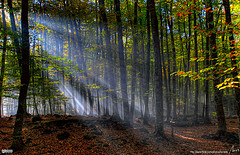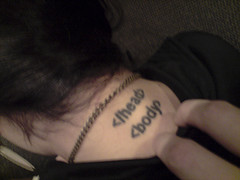February 20th, 2009 by Kevin Lindstrom | No Comments »
There are wide variety of CO2 calculators available on the web. Here’s a short list.
Government of Canada’s ecoACTION Tools and Calculators
EPA Climate Change – Greenhouse Gas Emissions Personal Emissions Calculator
My Carbon Footprint Carbon Calculator
Umweltbundesamt CO2 Rechner
Submitted by Kevin Lindstrom Liaison Librarian for Earth and Ocean Sciences, Chemical and Biological Engineering, Chemistry, Physics and Astronomy, and Geography.
Posted in Atmospheric Science, Chemical and Biological Engineering, Earth and Ocean Sciences, General Science, Geography, Main, Mechanical Engineering, Science - undegraduate classes | No Comments »
February 19th, 2009 by Eugene Barsky | No Comments »

Our new article – “Comparing Safari Tech Books Online and Books24x7 E-book Collections: A Case Study from the University of British Columbia Library” has just been published this week in the Issues in Science and Technology Librarianship.
It is open access and is available for everyone.
Abstract:
Most academic libraries are seeking to provide electronic access to the very dynamic and changing field of technology related material. Safari Tech Books Online and Books24x7 are the major e-book collections in this area. We compared the Safari Tech Books Online and Books24x7 e-book packages as to their usefulness for the University of British Columbia Library, second largest academic library in Canada. In our sample, we found that Books24x7 had more titles to offer (25% more); the overlap between the collections was relatively small (13-16%) and publishers varied considerably; and although there were no major differences in the “usefulness” measures of the titles in the two packages (Amazon.com ratings, WorldCat holdings and Reviews.com reviews were quite similar for both packages), O’Reilly titles, available only through Safari Tech Books Online, were held by a slightly higher number of libraries worldwide. We conclude that in order to have comprehensive coverage of this constantly changing area of knowledge, a large research academic library needs to subscribe to both collections. If subscribing to both collections is not an option, we recommend selecting a package based on the pricing that the library can negotiate with ProQuest, the vendor of both products, since the collections are complimentary in their nature.
Please feel free to ask us any questions or follow-up with this area of ebooks evaluation.
** photo by Adrian
Posted in General Science, Main, Mathematics, News, Science - undegraduate classes | No Comments »
February 13th, 2009 by Kevin Lindstrom | No Comments »
The 4.02m Euro project aims to create a universal emulator that can open and play obsolete file formats.
Using the emulator, researchers hope to ensure that digital materials such as games, websites and multimedia documents and are not lost for good.
For the full story, go to BBC News Technology section.
Submitted by Kevin Lindstrom Liaison Librarian for Science and Engineering
Posted in Main | No Comments »
February 6th, 2009 by Kevin Lindstrom | No Comments »
The University of British Columbia Library and Springer are delighted to introduce a new Print on Demand feature linked to the Library’s eBook collection: MyCopy powered by SpringerLink.
As a current faculty member of the University of British Columbia, MyCopy allows you to order your own personal print copy of a Springer eBook included in the Library’s collection. The individual copy will be delivered as a printed soft cover version directly to your doorstep. Best of all, it will be available to all patrons for just $24.95 (USD plus GST & PST, including shipping and handling costs).
The University of British Columbia Library is one of the first libraries to introduce the MyCopy service that includes more than 11,000 eBooks out of a total of 30,000 eBooks available on SpringerLink. We invite you to take a look, browse this comprehensive eBook collection and take advantage of the MyCopy service.
If you find an eBook that you would like to use for a course, you can simply copy the URL in the address bar on SpringerLink and add this to your course syllabus. The students can then follow the URL and purchase the eBook directly on http://www.springerlink.com for home delivery.
Below are directions for ordering a MyCopy book for just $24.95 (USD plus GST & PST, including shipping and handling costs)
1. Go to SpringerLink: http://www.springerlink.com
2. Search or browse eBooks in your research area (Available titles will have an orange MyCopy label associated with it.)
3. Click on the eBook or eBook chapter of your interest
4. Click on the MyCopy Logo found underneath the eBook or eBook chapter information, or the “add to shopping cart now” link within the orange box on the right hand column to start the ordering process.
We trust you will find this feature a valuable addition to Springer’s eBook collection. If you have questions, comments, or suggestions, please do not hesitate to contact UBC Librarians Joy Kirchner (joy.kirchner@ubc.ca) and Aleteia Greenwood (aleteia.greenwood@ubc.ca) or Springer at http://www.springerlink.com/feedback.
For a complete list of all Springer Ebooks including MyCopy titles go to the Springer eBooks by Subject Collection page and download the Excel spreadsheet for your discipline. Look for the column that contains the Springerlink openurl and paste this url into your browser.
Submitted by Kevin Lindstrom Liaison Librarian for the Physical and Applied Sciences.
Posted in Atmospheric Science, Chemical and Biological Engineering, Chemistry, Civil Engineering, Earth and Ocean Sciences, General Science, Geography, Main, Materials Engineering, Mathematics, Mechanical Engineering, News, Physics, Science - undegraduate classes, Statistics, Wood Sciences | No Comments »
February 4th, 2009 by Eugene Barsky | No Comments »

This is a quick post to remind you about various standards we have in the SciEng library:
* ASTM up to 2006
* CSA and ANSI standards up to 1995 (How to get those?)
* IEEE Standards: The IEEE Electronic Library provides access to over 1,000 current, revised and superceded standards in the field of electrical and computer engineering. You must be a UBC faculty, student or staff to access these resources. Print standards can be found in the UBC Library catalogue, though coverage varies.
* ISO: We own a number of ISO standards that are listed individually in our library catalogue, mostly from the early 1990s. Try typing ISO and standard? in catalogue search box.
* Open Access Standards (Free):
a.International Telecommunications Union (ITU-T)
b. International Organization for Standardization (ISO) and International Electrotechnical Commission (IEC) Standards. The Standards Council of Canada will grant a license for use of ISO and IEC international standards by recognized Canadian educational institutions in a credit course. Please contact us to learn more about this option.
Please do not hesitate to contact Kevin Lindstrom or Eugene Barsky if you require any additional info!
** Photo by Sifter
Posted in Atmospheric Science, Chemical and Biological Engineering, Chemistry, Civil Engineering, Earth and Ocean Sciences, General Science, Geography, Main, Materials Engineering, Mathematics, Mechanical Engineering, Physics, Science - undegraduate classes, Statistics, Wood Sciences | No Comments »
January 27th, 2009 by Eugene Barsky | No Comments »
This well-edited little video does a good job of tracing the rise of the internet from early networking efforts to birth of the TCP/IP protocol.
History of the Internet from PICOL on Vimeo.
UBC Library has a number of books on this topic as well. Try searching for Internet AND history in our library catalogue.
Posted in Main, Science - undegraduate classes | No Comments »
January 20th, 2009 by Eugene Barsky | No Comments »

From the Food and Agriculture Organization of United Nations (FAO) website:
http://www.fao.org/forestry/52980/en/
This 17-minute video presentation, produced by FAO and the Forestry Commission of the United Kingdom, shows how much forests can contribute to the mitigation of climate change, stressing the importance of reversing forest loss.
Forests store more carbon than all the world’s remaining oil stocks. Continuing deforestation and forest degradation account for almost one-fifth of the world’s greenhouse gas emissions – more than the entire global transport sector. The presentation explains how society can combat climate change by conserving and managing existing forests, by tackling causes of deforestation and by planting new forests. It stresses the use of wood as a renewable energy source and as a raw material, pointing out that wood products store carbon for their entire lifetime, until they decay or are burned. A section on adaptation notes how the world’s changing climate will affect the health and composition of forests and stresses the importance of adapting and planning ahead for the changes.
** Photo by MorBCN
Posted in Earth and Ocean Sciences, Main, Science - undegraduate classes, Wood Sciences | No Comments »
January 15th, 2009 by Eugene Barsky | No Comments »

The US National Security Agency has helped put together a list of the world’s most dangerous coding mistakes.
Experts from more than 30 US and international cyber security organizations jointly released the consensus list of the 25 most dangerous programming errors that lead to security bugs and that enable cyber espionage and cyber crime. Shockingly, most of these errors are not well understood by programmers; their avoidance is not widely taught by computer science programs; and their presence is frequently not tested by organizations developing software for sale.
BBC news article lists the mistakes here – http://news.bbc.co.uk/2/hi/technology/7824939.stm
** Photo by Marco Gomes
Posted in Amusing stuff, Main, Mathematics, News, Science - undegraduate classes | No Comments »
January 9th, 2009 by Kevin Lindstrom | No Comments »
Professor David McClung from the Department of Geography has published more than forty articles dealing with slab avalanches, avalanche risk, and avalanche forecasting.
Dr. McClung’s most recent publications include
Expanding the snow-climate classification with avalanche-relevant information: initial description of avalanche winter regimes for southwestern Canada. Haegeli, Pascal; McClung, David M. Journal of Glaciology, Volume 53, Number 181, March 2007, pp. 266-276.
Dry snow slab shear fracture speeds McClung, D.M. Geophysical Research Letters, Volume 34, 2007, L10502.
Snow Avalanches as a Non-critical, Punctuated Equilibrium System in Nonlinear Dynamics in Geosciences, Springer Verlag, 2007.
Thinking about heading into the back country? It might be useful to consult the Avalanche Handbook coauthored by David McClung and Peter Schaerer.
Other relevant avalanche websites include:
BC Provincial Emergency Program Avalanche Information
Canadian Avalanche Centre
Canadian Avalanche Foundation
Submitted by Kevin Lindstrom Liaison Librarian for Earth and Ocean Sciences, Physical Geography
Posted in Atmospheric Science, Civil Engineering, Earth and Ocean Sciences, Geography, Main | No Comments »
January 5th, 2009 by Eugene Barsky | No Comments »
The 2008 edition of this ever popular video is out for the masses.
I enjoyed to view it for the first time a couple of years ago and I have to admit that the video did not change much.
However, it might still surprise and entertain you:
Posted in Amusing stuff, Main | No Comments »




